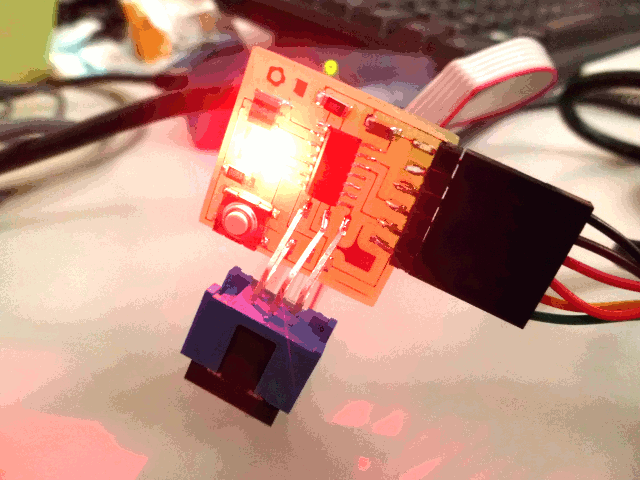 here my program : hello.ftdi.44.blink.asm.zip
here my program : hello.ftdi.44.blink.asm.zip
TP of the Week fabacademy is to become familiar with the programming of microcontrollers and processors. I'll start by programming the circuit that I realized few weeks ago: the helloWorld board.
First I check my board by flashing it with the example, following the protocol of the tutorial.
Avrdude say "thank you" : it's a good sign, but unfortunaly, the serial connection don't responds.
exploring different codes I found an Neil's Comment "lfuse set to 0x7E for 20 MHz xtal"
but in the makefile that I used, the fuse is Set to 0x5E
I try to understand the datasheet to solve this problem ...
In the datasheet, it is question of the calibration of the oscillator :
"... OSCCAL = 0x7F Gives a higher frequency than OSCCAL = 0x80 ..."
I have not been able to decode the exact code to understand what is this setting
but I see it comes to select the external clock and multiple clock.
In any case, the circuit works I can start trying to program
simply edit the Makefile by replacing:
by :
I chose easy: instead of writing in hexadecimal, I will use assembler ...
Based on the example of Neil, I'll try to do my LED flashing.
some ressources : french article
AVR Assembler User Guide
we need download the compiler gavrasm
Once unzipped the folder (or installed) you can compile a program with the command:
for example in my case :
I can compile my code, but the LED does not blink ...
I try a delay loop as this :
according my calculus : the loop takes 3 X 2 X 255^2 = 99488250 cycles
because the processor pulses at 20Mhz, the duration of the delay could be ~ 4,97 sec.
It is not : the LED don't blink visualy, so I think I do mistakes in my calculs...
but when I change the clock divider to 256 (according the datasheet)
flashing is apparent and about the expected duration. So I made calculation errors?
the LED now flashing, but I've lost my tiny !
If I try to upload another program I get :
On the advice of Neil, I try to use the "-i" avrdude, which specifies the time in microseconds between each bit change.
But this change nothing...
I finally found a solution here : use the-B option to delete the program in 1024 (this is the option Bitclock period)
phew!
I will NEVER change the clock divider more !
I gave the clock to its original timing.
But heck! as it is difficult to wait the clock which rotates dizzying pace of 20 million cycles per second!
I finally found a more or less elegant solution, using two coupled records (in the form of words) that instead of cap 255, reaching 65535: it's been more cycles.
Experimentally, I found this loop runs around in a centiseconde.
Ie if you set the registry "temp" 100 the last time for a second:
and it works!!
 here my program : hello.ftdi.44.blink.asm.zip
here my program : hello.ftdi.44.blink.asm.zip
To make a little easier, I'll try to program the button in C.
pins:
PA7: button (to set pullup)
PB2: LED
some useful resources:
to understand the inputs and outputs http://avrbasiccode.wikispaces.com/
My program will adjust the flash rate my led with the button.
To do this, I need to make a variable delay.
When you press the button, a counter which serve for the period of flashing LED is incremented:
The basic function "_delay_ms" is certainly more convenient to use than in assembler, but it takes only constants, not variables.
to manage a variable time I was inspired by this page
creating a long_delay function:
File: Hello.blink.button.44.zip
My program works pretty well, but it could works better, I should attach an interrupt to the button, because when the LED is blinking in its phase, the button is inactive.
but I lack time to implement it this week.
To be continued ...
As recreation, I try highlowtech hardware library to program directly from the tiny Arduino interface.
The purpose of the program is to adjust the luminance of the LED by pressing more or less time the button:
I found that the delay does not fully correspond with what is encoded as if the clock was multiplied: my period lasts about 200ms instead of 40ms in the code.